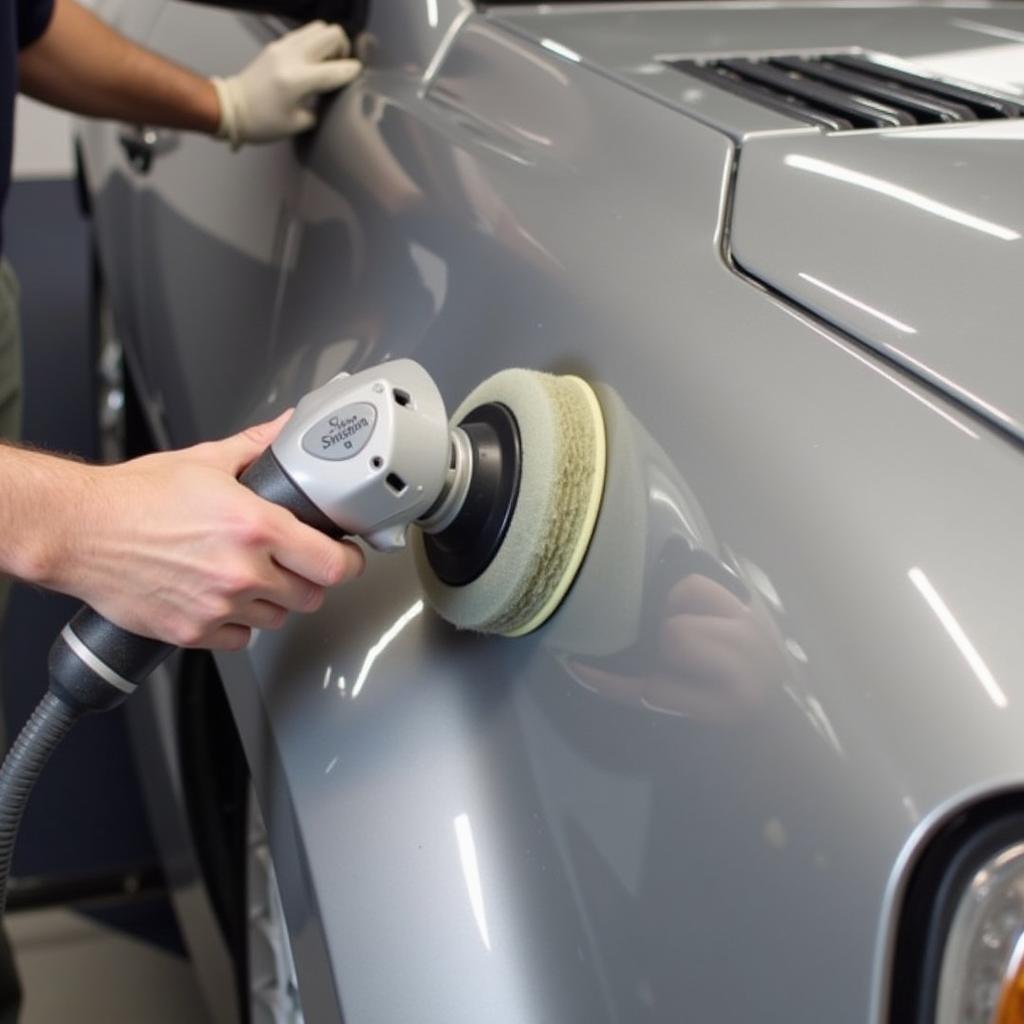Smoothing a fresh car paint repair is crucial for achieving a professional, seamless finish. Whether you’re dealing with a minor scratch or a larger area of damage, the process requires careful attention to detail and the right techniques. This guide will provide a comprehensive overview of how to smooth fresh car paint repair for a flawless result.
After applying the new paint, allow it to dry according to the manufacturer’s instructions. This is essential before beginning the smoothing process. Rushing this stage can lead to imperfections and compromise the overall finish. You’ll find this step significantly affects the final outcome of your car paint repair. You might be interested in learning more about how long car paint takes to settle, which you can find more about at car repair paint settle days.
Wet Sanding: The Foundation of a Smooth Finish
Wet sanding is the primary technique used to smooth fresh car paint. It involves using progressively finer grit sandpaper lubricated with water to level out the paint surface and remove any imperfections like orange peel or dust nibs.
Getting Started with Wet Sanding
Start with a relatively fine grit sandpaper, such as 1500 or 2000 grit. Soak the sandpaper in water for at least 10 minutes before starting. This softens the abrasive and helps to prevent scratching the paint. Use a sanding block to ensure even pressure and avoid creating uneven spots. Keep the surface wet by regularly spraying it with water.
Progressing Through the Grits
Gradually move to finer grits of sandpaper, such as 2500 and 3000 grit. Each grit level will refine the surface further, removing the scratches left by the previous grit. Be patient and methodical, focusing on achieving a smooth, even surface. After each sanding stage, thoroughly clean the area with clean water and a microfiber cloth. Inspect the surface carefully under good lighting to ensure all imperfections have been removed. If any imperfections remain after the final sanding stage, it will require additional attention. For information on fixing specific spots in a paint repair, check out this resource on how spot in a paint repair on car.
Polishing: Bringing Out the Shine
After wet sanding, the paint will appear dull. Polishing is the next step to restore the shine and gloss.
Choosing the Right Polish
Use a high-quality automotive polishing compound. Apply a small amount of polish to a clean microfiber polishing pad. Work the polish onto the paint using a circular motion with moderate pressure. Overlap each pass to ensure even coverage. Continue polishing until the desired level of shine is achieved.
Buffing for a Mirror Finish
Following polishing, use a clean microfiber buffing pad to remove any remaining polish residue and bring out the final shine. Buffing will enhance the gloss and depth of the paint, resulting in a professional-looking finish. This guide helps you smooth a car paint repair efficiently. If you are looking for professional car paint repair services in Salisbury, you can find some helpful resources at car paint repair salisbury.
 Polishing freshly painted car to restore shine
Polishing freshly painted car to restore shine
Common Mistakes to Avoid
- Rushing the drying process: Allow the paint to fully cure before sanding.
- Using too coarse of sandpaper: Start with a fine grit to prevent scratching.
- Applying too much pressure: Use even, moderate pressure during sanding and polishing.
- Skipping grits: Gradually progress through finer grits for optimal results.
- Using dirty or contaminated materials: Ensure all materials are clean and free of debris.
“Patience and attention to detail are key to achieving a flawless finish when smoothing fresh car paint,” advises John Smith, an automotive paint specialist with over 20 years of experience. “Taking your time and following the proper steps will result in a professional-looking repair that will last for years to come.” For car paint repair services in Miami, Florida, check out car repair paint miami florida.
Conclusion
Smoothing fresh car paint repair is a multi-step process that requires patience and attention to detail. By following the techniques outlined in this guide, you can achieve a smooth, professional-looking finish. Remember to allow the paint to fully dry, use progressively finer grits of sandpaper during wet sanding, and follow up with polishing and buffing to restore the shine. If you’re in Tulsa and need car paint repair, here’s a helpful link: tulsa repair car paint.
FAQ
- How long should I wait before wet sanding fresh paint? Always follow the paint manufacturer’s recommendations.
- What type of sandpaper should I use for wet sanding? Use automotive-grade wet/dry sandpaper.
- Can I use a machine polisher? Yes, a machine polisher can speed up the process but requires practice.
- How often should I replace the sanding and polishing pads? Replace them as soon as they become worn or contaminated.
- How can I prevent orange peel in my paint repair? Proper paint application techniques are crucial for preventing orange peel.
Need assistance? Contact us via WhatsApp: +1(641)206-8880 or Email: [email protected]. We offer 24/7 customer support.

